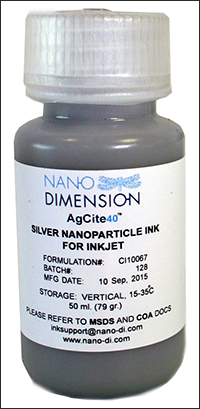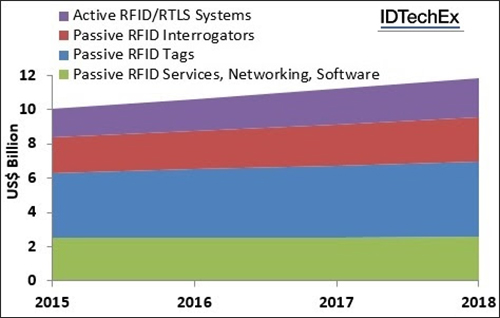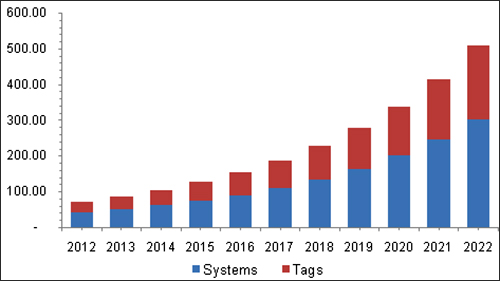Oct 22, 2015The following are news announcements made during the past week by the following organizations:
Invengo Technology;
Stanley Healthcare;
Nano Dimension;
IDTechEx Research;
Trimble's ThingMagic division; and
Grand View Research Inc.
Invengo Technology Announces New Channel Partner Program
Invengo Technology, has announced its Invengo InPower Partner Program, a global channel partner program designed to promote the company's RAIN ultrahigh-frequency (UHF) passive RFID tags, inlays, readers and antennas to a global ecosystem of strategic partners. The program is aimed at helping Invengo's business partners deliver solutions to end users across a spectrum of applications, markets and geographies. Invengo says it will also use the program to share the in-depth knowledge and expertise it has built up during the last 20 years.
"The Invengo InPower Partner Program is the next logical step in our strategic choice to market our products through a select group of dedicated channel partners," said Scott Medford, Invengo's chief sales officer, in a prepared statement. "We are firm believers in the added value of a channel partner approach to deliver the best possible solutions to the end customer."
According to Invengo, the InPower Partner Program is tailored to optimize the entire chain, from design and manufacture to marketing and sales, by ensuring that each business partner in the chain is able to focus on its own area of expertise. The program gives systems integrators and value-added resellers (VARs) access to Invengo's hardware, including RAIN RFID fixed, handheld and all-in-one readers supported by a range of antennas. In addition, participants in the program can profit from the latest product developments, such as the XC-1003 (to be released in December 2015), a smartphone-style handheld with an integrated RAIN RFID reader.
Invengo's InPower Partner Program provides competitive product discounts, demonstration programs, opportunity registration options, and strategic consulting and support through Invengo's certified distributors and its own sales and technical associates. The program also provides Web-based product and support information and regular product certification training. The program has a tiered level structure that classifies business partners in Silver, Gold or Platinum levels, based on clearly defined criteria.
Stanley Healthcare Unveils New Emergency Call Products for Senior Communities
Stanley Black and Decker's Stanley Healthcare division, a provider of visibility solutions and analytics for the health-care industry, has announced enhancements to its AeroScout real-time location system (RTLS) for senior living: the P10 Wi-Fi Resident Pendant and the Wi-Fi Emergency Call Station. According to Stanley Healthcare, its senior-living solutions are designed to protect residents anywhere within senior-living communities, as well as staff members, and employ a Wi-Fi network to locate residents, workers and equipment in real time with a high level of accuracy. Stanley Healthcare's senior-living portfolio includes not only the Wi-Fi Emergency Call Stations, but also its Healthcare Wander Alerting, Staff Assist, Environmental Monitoring and Equipment Management solutions.
The emergency call functionality provided by the new pendant and call station further extend the capability of the AeroScout solution. Now, residents carrying the P10 pendant can call for help from any location with Wi-Fi coverage, even outside on the grounds. The new, Wi-Fi Emergency Call Stations in resident rooms provide a further layer of security for residents, personnel and visitors. The pendants and call stations work with the company's MobileView software for the AeroScout solution, providing an enterprise-grade platform to manage alerts and document the changing needs of residents. The location, status and movement of residents can be viewed in real time and historically. Alerts can also be directed to staff members through a variety of means, including IP phones, pagers, mobile devices, e-mail and text messages. Customized maps make it easy to quickly determine a resident's location, with information automatically updated via mobile devices, smartphones and workstations.
The new Wi-Fi Emergency Call Station is a fixed-point device for residents, employees or visitors to call for help in the event of an emergency. It is installed in each resident's room, and at regular intervals around the facility. The device provides a flexible option over a traditional wired station, and can be repositioned as needed for each resident.
Unlike other solutions that only activate in a duress situation, the updated P10 pendant transmits its location on a regular basis. This detailed location information, combined with the call history from the Wi-Fi Emergency Call Stations, helps senior-living communities monitor resident activity levels to form a more precise picture of each resident for care planning, reimbursement and staffing-level analysis, Stanley Healthcare explains.
The pendent is smaller and lighter than previous models, features a large, easy-to-press button with a tactile surface. and provides positive visual and audible feedback to confirm successful button presses and other actions. It meets the IP 67 standard for dust and water resistance, can be configured and upgraded via the Wi-Fi network and has a replaceable battery with one to three years of battery life, depending on usage. The P10 pendant can be worn with a length-adjustable breakaway lanyard or a belt-clip. Colored clip-ons also allow for personalization of the tag.
Stanley Healthcare says that the P10 pendant has been "validated" in the facilities of its customers, including San Francisco Towers, part of Episcopal Senior Communities. "The reaction to the new pendant has been very positive. Residents appreciate the new look and the fact that the button is easy to press. It really creates a sense of comfort," said Pamela Stitt, San Francisco Towers' director of health services, in the prepared statement. "One of our core goals as an organization is to maximize the potential of each resident. Anything that encourages safe mobility for residents helps us in our mission."
The P10 Wi-Fi Resident Pendant is expected to be available by the end of 2015, with the Wi-Fi Emergency Call Station's release planned for the first quarter of next year.
Nano Dimension Debuts Silver Nanoparticle Inks for Printed Electronics, Including RFID
Nano Dimension Ltd., a printing electronics firm specializing in 3D printing, has announced its AgCite line of conductive silver nanoparticle inks for inkjet deposition.
The AgCite family of inks sinters at low temperatures, according to the company, and is suited to a range of substrate surfaces, including paper, polymers, glass and a range of coatings, applied using inkjet printing. Nano Dimension can formulate custom inks and change the adhesion, flexibility and hardness to meet the requirements of specific printing processes and applications. The formulation expertise makes AgCite inks applicable for a variety of advanced printed electronics applications, Nano Dimension reports, including RFID, organic light-emitting diode (OLED) lighting, circuits, screen bezels, solar, sensors and other applications requiring high conductivity.
The benefits of digital inkjet printing with AgCite inks include the ability to produce with less material and a cleaner process, and a more flexible and precise production process. According to the company, the inks are suitable for use in low-volume applications, operating costs are lower and there are no setup costs.
The benefits and properties of AgCite inks are enabled via a patented, highly efficient and environmentally responsible nanoparticle synthesis process, according to Nano Dimension. The process is licensed through Professor Shlomo Magdassi and Yissum Research Development Co., the technology transfer company of the Hebrew University of Jerusalem. The nanoparticle synthesis process begins with a silver precursor raw material and allows for fine control of the size, shape and distribution of the silver nanoparticles in accordance with customers' printing requirements. This nanoparticle synthesis process, the company indicates, is critical to the types of nanoparticles and ink formulations that can be produced.
Nano Dimension has two fully equipped laboratories: one dedicated to the research and production of conductive silver nanoparticle inks, and the other focused on innovative dielectric nano-inks. In addition to creating specialty inks for customers, the labs are also focused on nano-silver and nano-polymers for Nano Dimension's forthcoming 3D printer for multi-layer printed circuit board (PCB) prototypes, known as the DragonFly 2020.
RFID Market Tops $10 Billion in 2015, IDTechEx Research Estimates
The RFID market is estimated to hit total sales of $10.1 billion this year, according to a new report from IDTechEx Research. The research firm says growth will continue in established markets but is also expected in new markets. More than one third, or 38 percent, of the 2015 market value is for the tags themselves, for a total of 9.1 billion tags being sold—up from 7.8 billion tags in 2014, including all of the main RF frequencies, as well as both passive and active tags—according to IDTechEx Research.
A significant part of the growth is attributed to passive, ultrahigh-frequency (UHF) RFID tags (also now known as RAIN RFID). UHF RFID is being widely adopted for tagging apparel, the research firm notes, with 3.75 billion tags used for that application alone in 2015 versus three billion in 2014. For shorter-range high-frequency (HF) RFID, growth can be attributed to banks' use of secure RFID cards enabling contactless payments, with just under two billion being sold for that and other contactless card applications this year. Near Field Communication (NFC) is part of HF RFID as well, and NFC tag sales (excluding payment and personal ID applications) in 2015 will amount to 230 million units for such applications as tagging computer game figures and setting up Bluetooth pairing of consumer electronic devices.
The continued growth has resulted in many new entrants in the market, the firm reports, and companies will have to carefully consider their positioning. For example, IDTechEx Research, which has studied the RFID sector since 1999, has profiled more than 150 RFID companies in China alone. Despite the growth, there are still only a handful of businesses with more than $100 million in RFID sales, though the company says several are now moving into that category.
IDTechEx Research's new detailed report, titled "RFID Forecasts, Players, Opportunities 2016-2026," assesses the entire industry. Historic sales of RFID are provided from 2005 to 2015. Tables break out the sales of RFID by tag numbers, average sales price and total market value for 39 application areas, in addition to reader and software sales. Research is based on interviews with players all over the world.
ThingMagic Readers Add Support for Gen2v2 Security Functions
Trimble's ThingMagic division has released new firmware that adds support for the EPC Gen2v2 standard to its Micro and Micro-LTE RFID reader modules. The division also released updates to software development kits (SDKs) and revised documentation.
The new firmware release, version 1.7.2, for Micro and Micro-LTE adds EPC Gen2v2 support as implemented by NXP Semiconductors' Ucode DNA tags. The Ucode DNA is a passive EPC Gen 2 ultrahigh-frequency (UHF) RFID chip that NXP says is the first to provide cryptographic authentication. Unveiled in April 2015 (see NXP Releases IC for Secure Encrypted UHF Reads), the Ucode DNA uses a dynamic password that changes with each read event and requires the verification of every password from a server, in order to prevent eavesdropping and tag cloning. In addition, the Micro module is now qualified to operate down to temperatures of -40 degrees Celsius (-40 degrees Fahrenheit)—with corresponding lowering of firmware-enforced temperature limits—and features support for return loss measurements on antenna ports to monitor antenna quality, support for antenna detection based on return loss measurements across the configured region, and support for reduced-bandwidth 900 MHz regions—using less than the full 902 to 928 MHz band sanctioned by the Federal Communications Commission (FCC) and Industry Canada (IC)—to accommodate small, high-gain antennas, including a regional setting that compresses 50 channels into a band 10 MHz wide, and another that compresses 50 channels into a band that is 5 MHz wide.
The MercuryAPI SDK has been enhanced to support the Micro's new functionality. There is also support for Gen2v2's "Untraceable," "Secure Tag Authentication" and "Tag Authentication with Secure Data Transfer" functionalities on all three programming platforms (C, C#/.NET, and Java), and additional code examples are provided to illustrate the use of Gen2v2 functions. The SDK now has Return Loss reporting in the existing ReaderStats code example, two new screens for the Universal Reader Assistant application to demonstrate Gen2 v2 functionality, and support for antenna detection for the Micro module in Universal Reader Assistant and the Autonomous Configuration Tool.
In addition to release notes for the Micro firmware and API releases, the following manuals have been updated to reflect this release: Auto Configuration Tool Users Guide; M6e-Micro Hardware Guide; MercuryAPI Programmers Guide; Universal Reader Assistant User Guide; Nano Module Design Guide (not related to this release, but the documentation needed updating to clear up some ambiguity involving signal direction).
Global RFID Blood-Monitoring Systems Market to Top $500 Billion by 2022
The global RFID blood-monitoring systems market is expected to reach $511.5 million by 2022, according to a new report by Grand View Research Inc. Key growth factors attributing to its rapid growth, the research firm says, include increasing prevalence of chronic diseases, such as those of the heart, kidneys, lungs and liver, as well as other contagious and non-contagious diseases.
RFID is increasingly being used to identify, classify and track blood samples, and to automate data collection. The RFID tags are attached to blood samples to ensure easy and more accurate monitoring of the samples in hospitals, blood banks and diagnostic centers, Grand View Research explains. RFID tagging is an affordable and systematic inventory-management solution for such large-scale testing and storage of blood. Furthermore, increasing health-care expenditure, in addition to a rising demand for preliminary health-care checkups for early detection and diagnosis, are also expected to positively reinforce the market growth in the next seven years, the firm reports.
Key findings from the report suggest that in 2014, North America held more than 50 percent of the market, largely due to the presence of advanced health-care infrastructure and a high level of collaboration between the industry and stakeholders. The Asia-Pacific region is expected to be the fastest-growing area, with a compound annual growth rate of 23.2 percent predicted during the next seven years. Key factors attributing to its rapid growth include economic development in countries such as China, Brazil, India and South Korea. Increasing disease prevalence rates leading to a subsequent rise in blood diagnostics and blood inventory management are expected to boost usage rates of RFID blood-monitoring systems and tags over the forecast period. Key players in the RFID systems and tags market, according to Grand View, include WaveMark, LogTag, Tagsys RFID Group, Terso Solutions, Solstice Medical, Stanley Healthcare, LogiTag and Mobile Aspects.
The full research report is available for purchase here.




